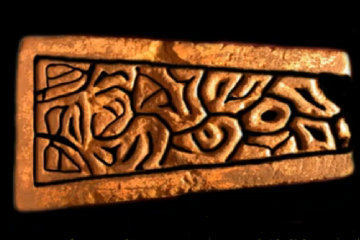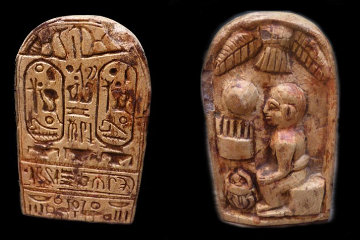The Gullible Archaeologist?
James Balme, archaeologist and television presenter, is well acquainted with self-publicity. He has appeared on Channel 4's Time Team, but he also has his own channel on You Tube. The trouble is, what do you do - as an archaeologist - when you have a much publicised series of programmes to make and the discoveries simply do not appear?

| |
| James Balme (on the left) and Tony Robinson (right), a colleage from the Time Team. |
If you are a presenter on the Time Team the answer is simple: you string out scenes of the excavation, turn a passing rain shower into a major drama, provoke dissension within the team, and waste hours interviewing "experts" on the subject of what might be under the ground. That means that you can relegate the admission that, in fact, you found nothing whatsoever and were actually digging in the wrong spot, to the final twenty seconds of the programme. Viewers are left with bitten nails and the vague impression that they have been watching one of the epochal excavations of modern times.
It is less easy when you are producing your own film for YouTube. In the first place you have to keep your costs down and without the backing of a profligate TV company you can't afford the experts and the volunteers. In the second place television has the advantage of viewer inertia. You've started watching the programme and there's nothing on the other channels and anyway the remote has just been eaten by the dog, so you might as well keep watching. On YouTube, however, another ten million films are only a click away and if the film you are watching fails to grip you simply run your mouse down the list of films on the right and choose another.
The pressure is on, therefore, for Mr Balme to find something dramatic every five minutes and some of his "discoveries" are dubious, to say the least. Take, for example, the piece of stone he found recently in someone's garden. Hyped on YouTube as "Saxon Carved Stone - Another Great Discovery" and "The Mystery of the Carved Stone", the accompanying blurb goes into rhapsodies.
The mystery carved stone recently recovered by James Balme resulted in worldwide interest and coverage across many news platforms, Livescience.com, NBC News, Discovery, Fox News & The Daily Mail Online to name but a few. Of course the story was of great interest to thousands of people, and of course as expected there were critics of the find, even though they had not physically examined the carving in person. Close on hand inspection tells a different story. Some even came up with a theory that it was machine made ?? Well in this film take a closer look in far more detail at the carving and you will see that it is indeed carved purely by hand !!! Research will take many months to establish the exact meaning of the carving but as with all these type of objects there is no straightforward answers .........

| |
| I have chosen this highly manipulated image from Balme's YouTube channel, rather than the more natural photographs, to highlight the symbols. |
The spacing, punctuation and grammar in the above quote are all Mr Balme's own - perhaps someone ought to tell him that there are no straightforward answers when your subject is plural! As for the "worldwide interest", news-hungry reporters are only too glad to reprint a press release when there are no cafe sieges or Muslim kidnappings to hog the headlines.
As for the stone itself, I am no expert in Anglo-Saxon stone carvings. I will merely comment that it bears no relationship to the knot-work found on other stonework of the period that I have seen. What I will take issue with is Mr Balme's claim that the patterns are "some form of writing". He then hedges his bets by saying, "Regarding the carvings on the stone my initial feeling is that these are symbols rather than straightforward text." The reader is invited to study the picture opposite for themselves and reach their own conclusion as to whether the stone is evidence of the complete works of Shakespeare, an over-active imagination, or desperation to gain some publicity.
The latest news is that Mr Balme has purchased a seal of Rameses II from a charity website - a bargain at £12. We know it must be genuine because it has grains of sand stuck in the grooves!
Once again Mr Balme's press-agent goes into hyperdrive.
The hieroglyphics on the flat face of the stone should be able to be translated in the coming weeks telling us more about the history of the stone. As it seems that the cartouche is the royal seal of Ramesses II then it is plausible that the figure seated could be that of Ramesses himself. This is a real mystery at the moment but an exciting one nonetheless.

| |
| A bit of crudely carved stone that Mr Balme claims is the seal of Rameses II. |
It certainly would be exciting if this turned out to be the personal seal of Rameses II - but it would also be a sad commentary on the decay of the once-great Egyptian Empire if the mighty Rameses the Great was reduced to signing his royal decrees with something whose cartouches are as wonky as the ones on display here. Any Egyptian stone carver who presented his sovereign with a cartouche that was less than perfectly round at top and bottom would find himself shipped off to the gold mines in the eastern desert in very short order indeed!
A similar fate, I suspect, would await the artist who depicted Rameses II without his double crown or any other insignia of royalty and wearing what appears to be a badly fitted nappy - and as for the headless ba bird hovering above the figure ...!
In short, the object has every indication that it is a bit of stone, roughly carved by some peasant in a workshop in Luxor, to be sold for as high a price as can be extorted from a gullible tourist.
Does that make Mr Balme a gullible archaeologist? I may be wronging the man, but I don't think so. He is careful to say that "it bears the cartouche of Rameses the Great" and skirts round the idea that it is Rameses' personal seal - he hints that it might be but never actually says so. He claims that the object is being submitted to experts, but whether they agree with him that it is genuine, or agree with me that it is a fake, he has ten minutes of YouTube video out of it, interviews on news programmes, paragraphs in newspapers and even, if he has been very good and has built up enough karma from previous lives, Zahi Hawass may get in on the act and demand that the seal be repatriated to Egypt.
Who was the cynic who said that there is no such thing as bad publicity?
© Kendall K. Down 2015





